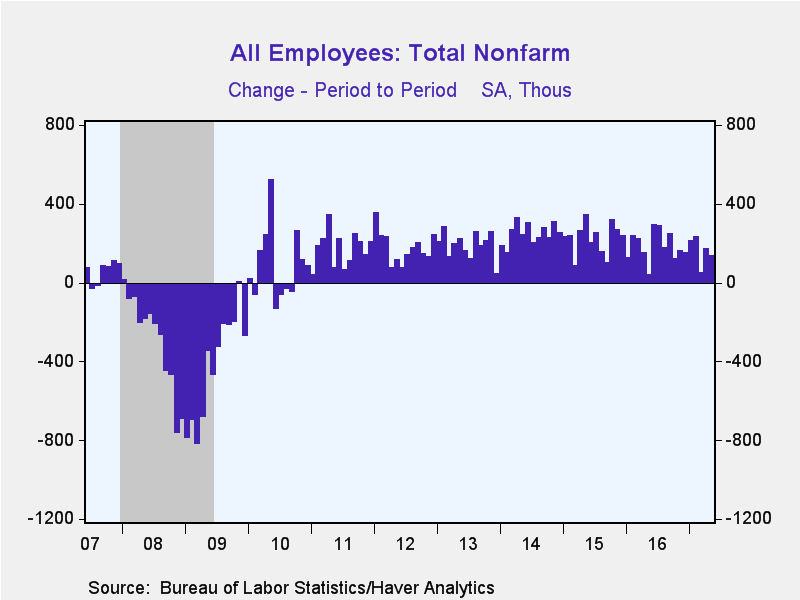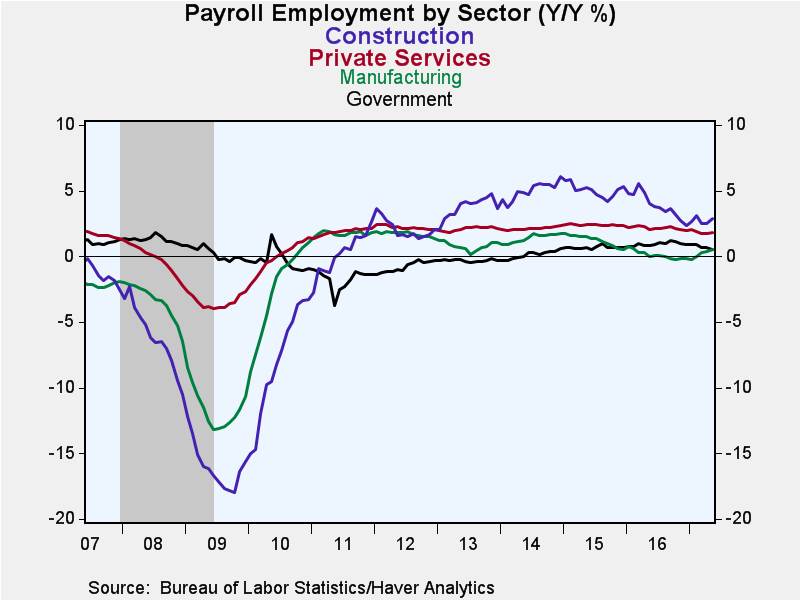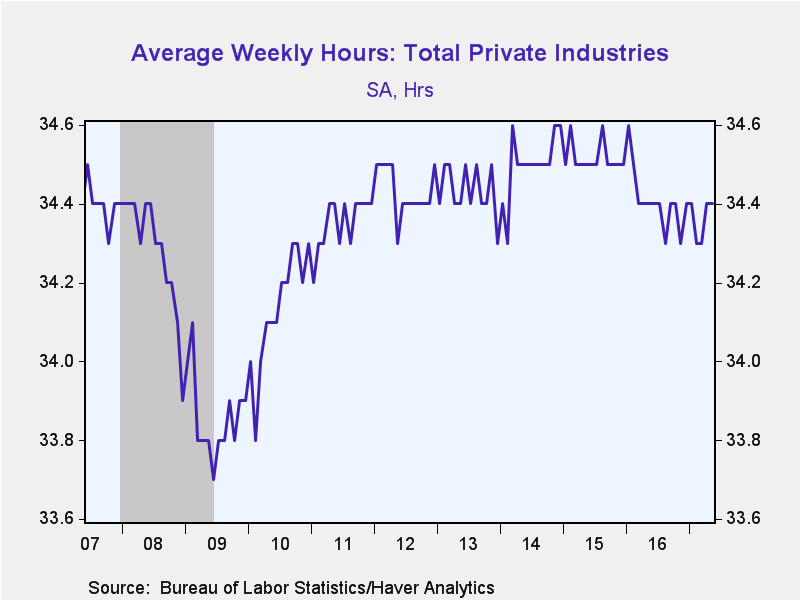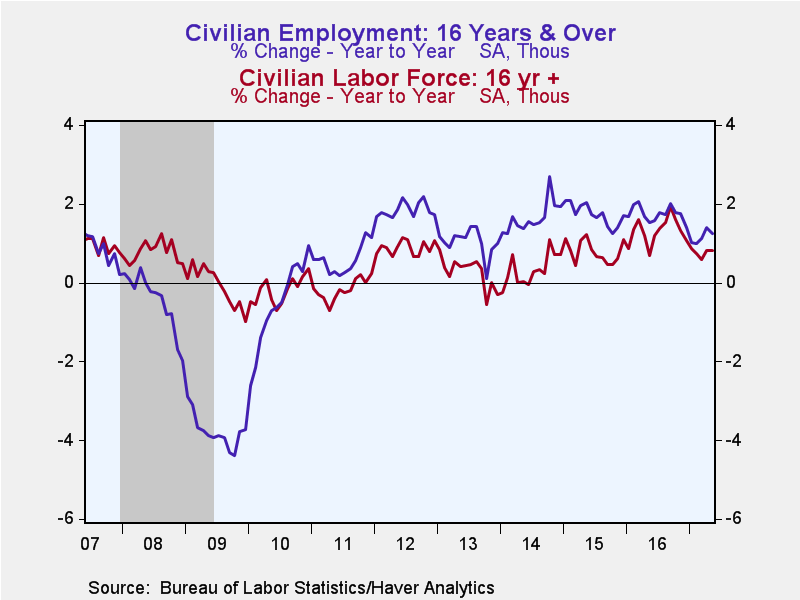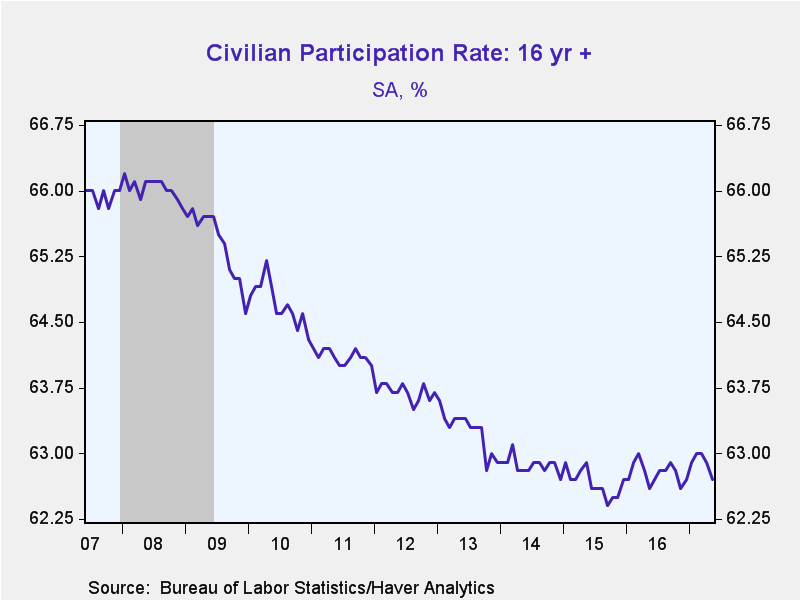 Global| Jun 02 2017
Global| Jun 02 2017U.S. Payroll Increase Disappoints; Jobless Rate Declines
by:Tom Moeller
|in:Economy in Brief
Summary
The May employment report sent mixed signals about labor market conditions. Nonfarm payrolls rose 138,000 (1.5% y/y) last month. A 182,000 increase had been expected in the Action Economics Forecast Survey. The rise followed a 174,000 [...]
The May employment report sent mixed signals about labor market conditions. Nonfarm payrolls rose 138,000 (1.5% y/y) last month. A 182,000 increase had been expected in the Action Economics Forecast Survey. The rise followed a 174,000 April gain and a 50,000 March increase. Together these figures were revised down by 66,000. Weakness in hiring was broad-based last month. Average hourly earnings increased an expected 0.2% (2.5% y/y) after 0.2% gain, revised from 0.3%. The unemployment rate declined to 4.3%. Stability at 4.4% had been forecast. The overall unemployment rate, including marginally attached workers and those working part-time for economic reasons, fell to 8.4%, its lowest level since November 2007.
From the payroll survey, the disappointing 138,000 increase in jobs lowered the average change during the last five months to 162,000 from 187,000 last year. Factory sector jobs eased 1,000 last month following five consecutive months of double-digit increase. Construction sector jobs grew 11,000 after a 1,000 decline. The average change this year of 20,000 compares to 13,000 last year. Employment in the mining sector improved 6,600 (5.3% y/y) following last year's 10.8% decline.
Weakness in service sector hiring was broad-based. A 131,000 job increase in private sector jobs last month lowered this year's average to 123,000 from 165,000 last year. Trade, transportation & utilities jobs fell 6,000 (0.6% y/y). So far this year, these jobs have also declined by an average of 6,000 per month after last year's 28,000 gain. Retail trade jobs declined 6,100 (+0.1% y/y) after last year's 3,000 average rise. Information services employment eased 2,000 (-0.7% y/y) and has been declining regularly since last June. Professional & business services jobs rose 38,000 (3.1% y/y). Its 46,000 average increase this year compares to 52,000 last year. Leisure & hospitality employment rose 31,000 (2.1% y/y) after a 58,000 increase, with average growth this year of 30,000. A 47,000 increase (2.3% y/y) in employment in the education and health services sector also was fairly steady.
Government sector jobs declined 9,000 versus a 1,000 average rise so far this year. Both are down from last year's average 17,000 gain. Local government hiring declined 9,000 (+0.5% y/y). It has risen an average 2,000 this year after last year's 13,000 average increase. State government jobs also fell 8,000 (+0.1% y/y), steady this year and last. Federal government jobs improved 8,000 (0.8% y/y), but slipped 1,000 per month so far this year. They rose an average 12,000 per month last year.
The length of the average workweek held steady at 34.4 hours. Factory sector hours remained at 40.7. Financial activities hours eased to 37.4 and information hours-worked were stable m/m at an elevated 36.3. Education & health services hours remained stable at 32.9 and leisure & hospitality hours eased to 26.0.
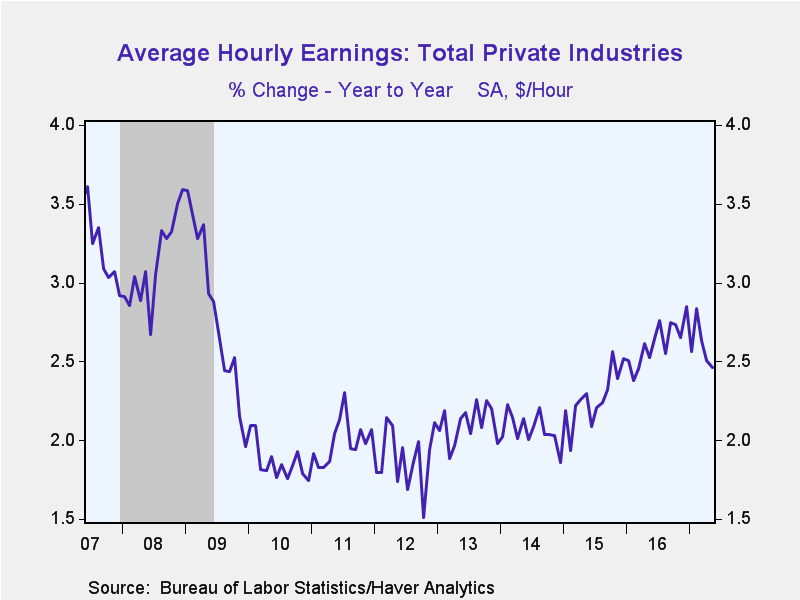 Average hourly earnings improved 0.2% as a 0.5% increase in
construction (2.2% y/y) offset a 0.5% decline in manufacturing (+1.8% y/y). Private service sector
earnings rose 0.2% (2.6% y/y). That reflected a 0.5% rise (4.3% y/y) in information services and a 0.2%
decline (+2.4% y/y) in professional & business services.
Average hourly earnings improved 0.2% as a 0.5% increase in
construction (2.2% y/y) offset a 0.5% decline in manufacturing (+1.8% y/y). Private service sector
earnings rose 0.2% (2.6% y/y). That reflected a 0.5% rise (4.3% y/y) in information services and a 0.2%
decline (+2.4% y/y) in professional & business services.
From the household survey, the unemployment rate dipped to 4.3%, the lowest level since May 2001. The decline was caused by a 429,000 fall (+0.8% y/y) in the labor force which exceeded the 233,000 drop (+1.2% y/y) in employment. The labor force participation rate fell to 62.7% and reversed the increases earlier this year. The average duration of unemployment rose m/m to 24.7 weeks, but was down from the high of 39.4 weeks in 2011 and 2012.
By educational attainment, persons with less than a high school diploma realized 6.1% joblessness. Those with a diploma but no college were 4.7% unemployed. Workers with less than a bachelors degree were 4.0% unemployed and those with a bachelors degree realized 2.3% unemployment.
The teenage unemployment rate of 14.3% reflected a 1.1% y/y rise in employment. Persons aged 25-54 were 3.8% unemployed as employment gained 0.7% y/y. Those aged 55 and over were 3.1% unemployed as employment improved 2.8% y/y.
The labor market data are contained in Haver's USECON database. Detailed figures are in the EMPL and LABOR databases. The expectations figure is in the AS1REPNA database.
Valuing Workplace Benefits from the Federal Reserve Bank of New York is available here.
Tom Moeller
AuthorMore in Author Profile »Prior to joining Haver Analytics in 2000, Mr. Moeller worked as the Economist at Chancellor Capital Management from 1985 to 1999. There, he developed comprehensive economic forecasts and interpreted economic data for equity and fixed income portfolio managers. Also at Chancellor, Mr. Moeller worked as an equity analyst and was responsible for researching and rating companies in the economically sensitive automobile and housing industries for investment in Chancellor’s equity portfolio. Prior to joining Chancellor, Mr. Moeller was an Economist at Citibank from 1979 to 1984. He also analyzed pricing behavior in the metals industry for the Council on Wage and Price Stability in Washington, D.C. In 1999, Mr. Moeller received the award for most accurate forecast from the Forecasters' Club of New York. From 1990 to 1992 he was President of the New York Association for Business Economists. Mr. Moeller earned an M.B.A. in Finance from Fordham University, where he graduated in 1987. He holds a Bachelor of Arts in Economics from George Washington University.


